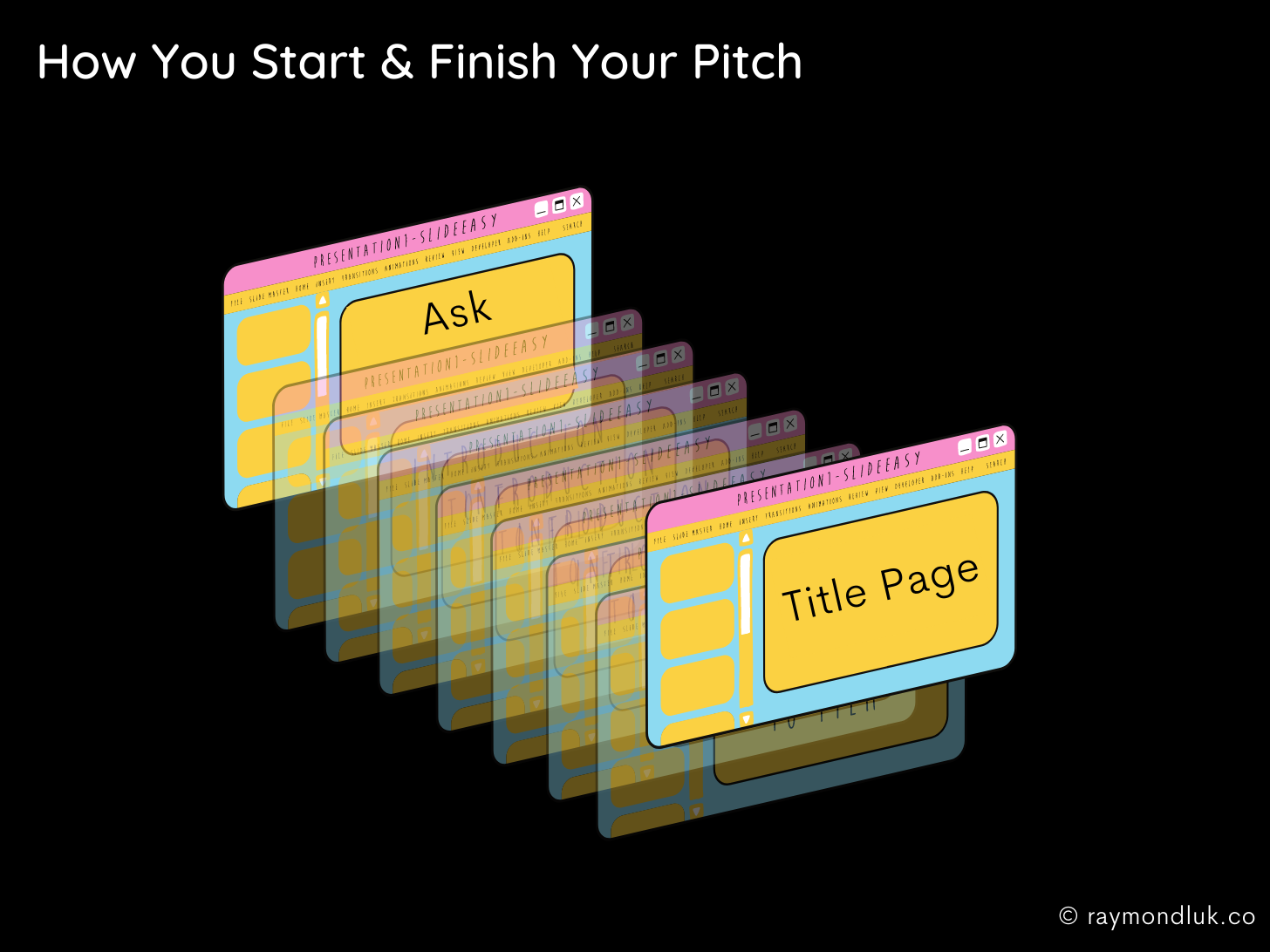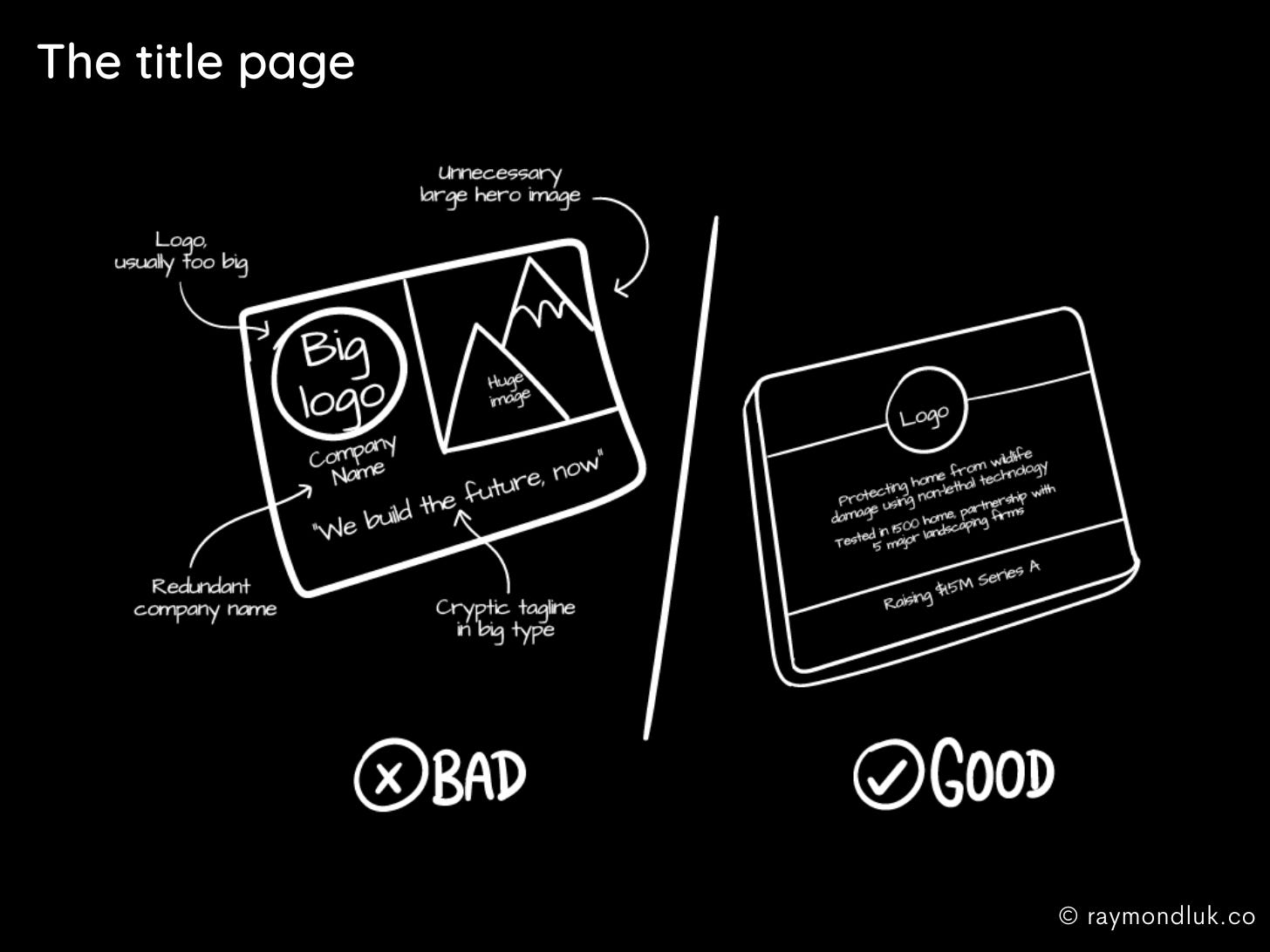
The bookends to your pitch deck are the title page (opening) and the ask (closing). It makes sense to create those slides last. How much you’re raising is the result of everything else you did in the pitch. I think it always makes sense to end with asking for the money. You won’t actually get a check thirty seconds after your pitch ends (DM me the story if you do) but you set the table for the conversation you want to have.
I think title pages are like movie posters. They actually help investors decide if they’re interested in watching the whole movie. If you’re presenting in person this is the slide everyone is staring at while they’re waiting for people to show up to the meeting. Or what a partner casually glances at on her phone between meetings.
Key points I cover:
- What to include in your ask
- How to make an effective title page
This is part 12 of a series that walks through the slides in a pitch deck. See Start With the Problem, and Your Startup’s DNA: The Solution Slide, How Not to Waste Your Product Slide, Why Now: Change is the Key to your Pitch, The Market Size Dilemma, How Not to Lie To Yourself About Competition, Telling the Story of How You Make Money, You've built a better mousetrap, now you need to go to market, How to talk about financial projections in your pitch deck, How to think about the team slide, and Why you've been thinking of traction all wrong.
Subscribe for free to receive weekly posts about pitching, a copy of my ebook Pitching a Leap of Faith, and invites to my Pitch Masterclass.
What to include in your ask
There is no reason not to have an Ask slide in your pitch deck - even if you’re doing “informational” pitches. The Ask is the whole point of the pitch deck.
This slide should say, “this is how much we need to achieve our vision and build something huge.” The amount you’re asking for is an important signal itself. If you’ve painted a huge vision and showed great traction but you’re under asking, the investor will wonder why. If you’re asking too much you’ll leave the impression that only throwing lots of money at the problem will solve it.
Two things to keep in mind:
- The amount you’re asking should be related to the losses / negative cash flow you need to fund to reach your next milestone. I’m not saying to raise exactly what you project to lose, to the dollar. No one knows that number. Just make sure the parts of your story are consistent.
- For the use of proceeds, avoid generalities like “salaries” or “working capital.” List the top 3-4 things (that were already established on previous slides) that you need to do with this funding. Always explain those expenses in terms of what result they buy.
About valuations
A lot of entrepreneurs ask if they should state details like their valuation in their deck. If you have a funding round in progress go ahead. Otherwise, I would leave it out because it’s not necessary for your initial pitch. If they’re asking you for your valuation, you’ve done something right.
How to make an effective title page
A lot of pitch decks waste the prime real estate that is the title slide. Having a giant logo, a fancy graphic and a tagline sure looks like the title page. But who cares? Use the space to make a good first impression. Don’t worry, you’ll have the rest of the pitch deck to tell your story.

Name/logo
If your logo already clearly spells out your company name, don’t state it twice. There’s also no need to clutter your title page with anything else like the CEO’s name and contact info, the location of your office etc.
Imagery
If you have a physical product, put it on your title page. For software products, think about whether a tiny screenshot adds anything. Usually it doesn’t. Avoid stock photos. Make the effort to take a real photo of a user or an environment, e.g. a clinic, where your product is used. Otherwise skip the imagery altogether.
Traction
Have one line summarizing your best traction. Not two lines and not one really long sentence. You could include MRR or active users or a key customer win or regulatory milestone.
Ask
How much you are raising, e.g. “Raising $2M Seed round”.
1-liner
I left this to the end because in some ways the entire process of building a great pitch deck is to prepare you for writing a great 1-liner. This is difficult to do because it’s not enough room to tell your whole story. Don’t try.
First, don’t use a tagline. It’s confusing and adds nothing to your pitch deck.
Then just focus on a straight up description of what you do. Not your vision or why you’re great or how you’re changing the world. Something like:
- Online barter platform for neighborhoods
- Rapid potency testing for cannabis manufacturing
- API for voice-enablement of e-commerce stores
This is even more basic than an elevator pitch which is ok. It should be simple enough to be able to say “Oh yeah, it’s that startup that does X.” Say what you do, how you sell it and who you sell to.
The most difficult thing to do on the title page is to give just enough information to be accurate, but to hold back from trying to do more.




